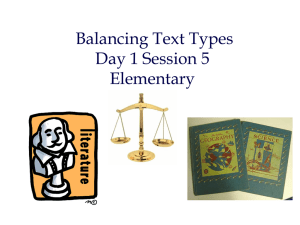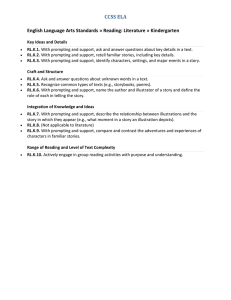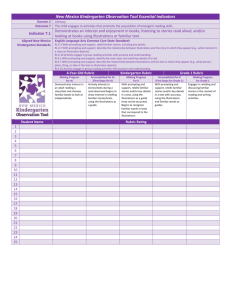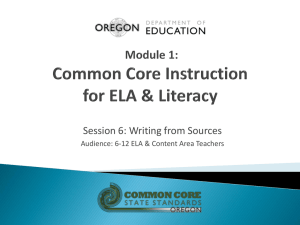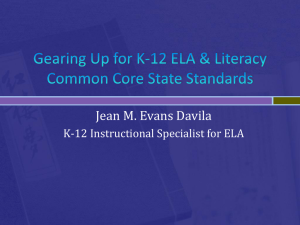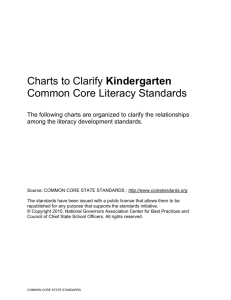CCSS for ELA: Reading Informational Text
advertisement
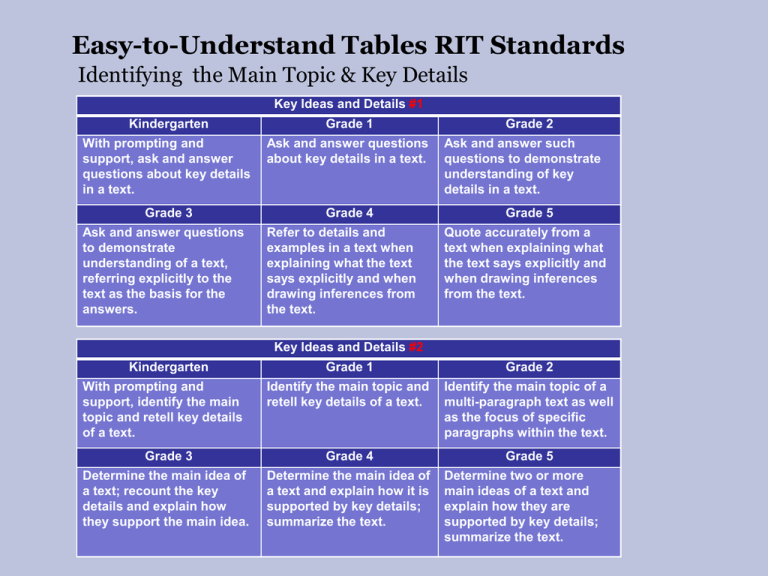
Easy-to-Understand Tables RIT Standards Identifying the Main Topic & Key Details Key Ideas and Details #1 Kindergarten Grade 1 With prompting and support, ask and answer questions about key details in a text. Ask and answer questions about key details in a text. Grade 3 Grade 4 Ask and answer questions to demonstrate understanding of a text, referring explicitly to the text as the basis for the answers. Refer to details and examples in a text when explaining what the text says explicitly and when drawing inferences from the text. Grade 2 Ask and answer such questions to demonstrate understanding of key details in a text. Grade 5 Quote accurately from a text when explaining what the text says explicitly and when drawing inferences from the text. Key Ideas and Details #2 Kindergarten Grade 1 Grade 2 Identify the main topic and retell key details of a text. Identify the main topic of a multi-paragraph text as well as the focus of specific paragraphs within the text. Grade 3 Grade 4 Grade 5 Determine the main idea of a text; recount the key details and explain how they support the main idea. Determine the main idea of a text and explain how it is supported by key details; summarize the text. With prompting and support, identify the main topic and retell key details of a text. Determine two or more main ideas of a text and explain how they are supported by key details; summarize the text. CCSS for ELA: Reading Informational Text Identifying Connections and Relationships Key Ideas and Details #3 Kindergarten Grade 1 Grade 2 With prompting and support, describe the connection between two individuals, events, ideas, or pieces of information in a text. Describe the connection between two individuals, events, ideas, or pieces of information in a text. Describe the connection between a series of historical events, scientific ideas or concepts, or steps in technical procedures in a text. Grade 3 Grade 4 Grade 5 Describe the relationship between series of historical events, scientific ideas or concepts, or steps in technical procedures in a text, using language that pertains to time, sequence, and cause/effect. Explain events, procedures, ideas, or concepts in a historical, scientific or technical text, including what happened and why, based on specific information in the text. Explain the relationships or interactions between two or more individuals, ideas, or concepts in a scientific, or technical text based on specific information in the text. CCSS for ELA: Reading Informational Text Building Vocabulary Craft & Structure #4 Kindergarten With prompting and support, ask and answer questions about unknown words in a text. Grade 3 Determine the meaning of general academic and domain-specific words and phrases in a text relevant to a grade 3 topic or subject area. Grade 1 Grade 2 Ask and answer questions to help determine or clarify the meaning of words and phrases in a text. Determine the meaning of words and phrases in a text relevant to a grade 2 topic or subject area. Grade 4 Grade 5 Determine the meaning of general academic and domain-specific words or phrases in a text relevant to a grade 4 topic or subject area. Determine the meaning of general academic and domain-specific words and phrases in a text relevant to a grade 5 topic or subject area. CCSS for ELA: Reading Informational Text Identifying Text Features & Structures Craft & Structure #5 Kindergarten Grade 1 Identify the front cover, Know and use various text back cover, and title page of features (headings, tables a book. of contents, glossaries) to locate key facts or information in a text. Grade 3 Use text features and search tools (e.g., key words, sidebars, hyperlinks) to locate information relevant to a given topic efficiently. Grade 2 Know and use various text features (captions, bold print, subheadings, glossaries, indexes) to locate key facts or information in a text efficiently. Grade 4 Grade 5 Describe the overall structure (e.g., chronology, comparison, cause/effect, problem/solution) of events, ideas, concepts, or information in a text or part of a text. Compare and contrast the overall structure (e.g., chronology, comparison, cause/effect, problem/solution) of events, ideas, concepts, or information in two or more texts. CCSS for ELA: Reading Informational Text Various Craft & Structure #6 Kindergarten Name the author and illustrator of a text and define the role of each in presenting the ideas or information in a text. Grade 1 Distinguish between information provided by pictures or other illustrations and information provided by the words in a text. Grade 2 Identify the main purpose of a text, including what the author wants to answer, explain, or describe. Grade 3 Grade 4 Grade 5 Distinguish their own point of view from that of the author of a text. Compare and contrast a firsthand and secondhand account of the same event or topic; describe the differences in focus and the information provided. Analyze multiple accounts of the same event or topic, noting important similarities and differences in the point of view they represent. CCSS for ELA: Reading Informational Text Interpreting Visual Elements Integration of Knowledge & Ideas #7 Kindergarten With prompting and support, describe the relationship between illustrations and the text in which they appear. Grade 1 Use the illustrations and details in a text to describe its key ideas. Grade 2 Explain how specific images contribute to and clarify a text. Grade 3 Grade 4 Grade 5 Use information gained from maps, photos, and other illustrations and the words in a text to demonstrate understanding where, when, why, and how key events occur. Interpret information presented visually, orally, or quantitatively (charts, graphs, diagrams) and explain how the information contributes to an understanding of the text in which it appears. Draw on information from multiple print or digital sources, demonstrating the ability to locate an answer to a question quickly or to solve a problem efficiently. CCSS for ELA: Reading Informational Text Examining How the Author Supports Points Integration of Knowledge & Ideas #8 Kindergarten With prompting and support, identify the reasons an author gives to support points in a text. Grade 3 Describe the logical connection between particular sentences and paragraphs in a text (e.g., comparison, cause/effect, first/second/third in a sequence). Grade 1 Identify the reasons an author gives to support points in a text. Grade 4 Explain how an author uses reasons and evidence to support particular points in a text. Grade 2 Describe how reasons support specific points the author makes in a text. Grade 5 Explain how an author uses reasons and evidence to support particular points in a text, identifying which reasons and evidence support which point(s). CCSS for ELA: Reading Informational Text Comparing Texts and Integrating Ideas Integration of Knowledge & Ideas #9 Kindergarten With prompting and support, identify basic similarities in and differences between two texts on the same topic Grade 1 Identify basic similarities in and differences between two texts on the same topic. Grade 3 Grade 4 Compare and contrast the most important points and key details presented in two texts on the same topic. Integrate information from two texts on the same topic to write or speak about a subject knowledgeably. Grade 2 Compare and contrast the most important points presented by two texts on the same topic. Grade 5 Integrate information from several texts on the same topic to write or speak about the subject knowledgeably.



